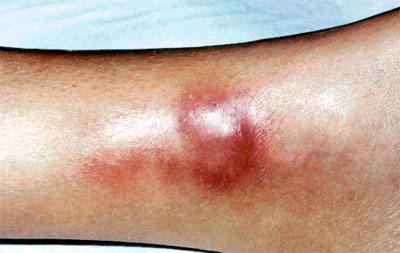|
|
|
Panniculitis
A nodular panniculitis is a descriptive term for panniculitis secondary to many causes.
Lesions are typically ill-defined, subcutaneous masses up to many centimeters across. Following destruction of the subcutaneous fat, depressions are common. Ulceration can also occur.
Causes of nodular panniculitis
- alpha1-antitrypsin inhibitor deficiency. Severe panniculitis can result from the deficiency of this protease inhibitor. Extensive areas of cellulitis-like involvement are seen, with ulceration common.
- Vasculitis of the larger, deeper vessels can result in a nodular panniculitis. Such a vasculitic process may include lesions of erythema nodosum, erythema induratum, and lupus panniculitis.
- Cold panniculitis. Cold injury to fat tissue can result in a panniculitis.
- Post-steroid panniculitis can occur secondary to the abrupt withdrawal of high dose systemic steroids.
- Idiopathic nodular panniculitis, also known as Weber-Christian disease, is of unknown etiology. Lesions most typical on the lower extremities, but can occur on the trunk. There can be an associated fever, malaise, arthralgia, and myalgia.
- Panniculitis secondary to pancreatic enzyme release. Chronic or acute pancreatitis can release lipolytic enzymes, which can cause fat necrosis.
Treatment:
- Alfa 1 – anti-trypsin deficiency
- A1AT concentrate
- Case report on the benefit of Dapsone and Colchicine
- Liver transplant could be considered in severe cases
- Nodular vasculitis may be treated with non-steroidal anti-inflammatories, potassium iodide, anti-malarials, Colchicine.
- Treat underlying tuberculosis

Back to Dermatology Glossary - P Index |
Back to Dermatology Glossary Index
|